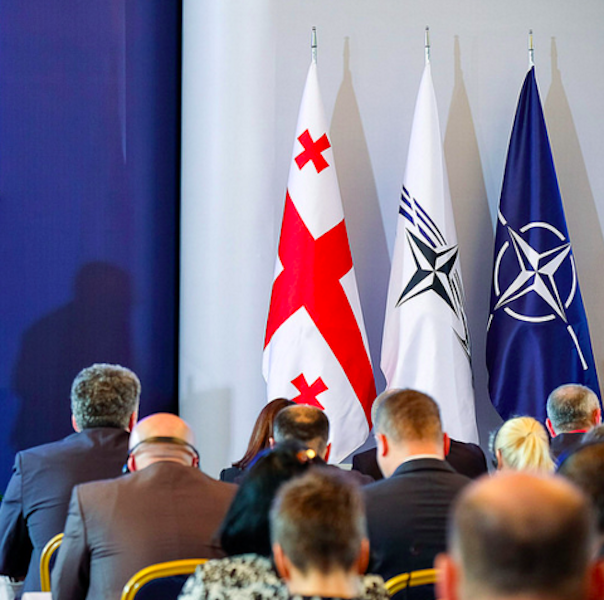The NATO Parliamentary Assembly was created in 1955 to provide a specialized forum for members of parliament from across the Atlantic Alliance to increase the awareness of parliamentarians on defence and security issues affecting the Euro-Atlantic area. The Assembly meets twice a year to conduct its business, hear expert presentations and receive reports from its committees. The most recent assembly was held in Tbilisi, Georgia, May 27-29, 2017.
There are five committees: Civil Dimension of Security; Defence and Security; Economics and Security; Political; and Science and Technology. Traditionally at the Spring Assembly the committees receive and discuss draft reports, to be finalized with input from the discussion for presentation at the Fall Assembly.
A key report discussed at the meeting of the Defence and Security Committee on May 27, was “Ballistic Missile Defence and NATO”, presented by the General Rapporteur of the Committee, Canada’s Senator Joseph Day. While it is still a draft report, the discussion revealed a high degree of congruence with the extremely well-researched content of the report.
Senator Day summarized the report starting with an overview of the growing threat of ballistic missile systems (BMS) as North Korea and Iran are steadily increasing the capabilities of both their nuclear warheads and their long-range missile systems.
Iran is particularly troubling as it is taking advantage of a loophole in the 2015 agreement that while it is not allowed to increase the production of nuclear-capable BMs, the agreement does not limit the Iranian BM program itself. It, therefore, continues to perfect an already sophisticated weapons system that is now capable of reaching Turkey.
North Korea’s ballistic missile advancements threaten Japan and South Korea, which do not have nuclear weapons or strategic missiles of their own, but have bilateral defence treaties with the United States to provide these capabilities. They do have Aegis systems on destroyers which allow them to share data with the United States for ballistic missile defence purposes.
The US Army announced plans in July 2016 to deploy a Terminal High Altitude Area Defense system (THAAD) missile battery to South Korea capable of intercepting short- and medium-range missiles during their initial or terminal phase of flight. This will provide defence of population centres, military forces, and resources on the Korean peninsula as well as some areas of Japan.
Both China and Russia have objected strongly to these plans. Russia is concerned about the overlap of the THAAD’s range on eastern Russian territory.
Another disconcerting issue is the willingness of some states to share technology with those willing to pay and thus there is an increasing danger that BM capability will be developed and eventually used by non-state actors.
The report states, that while there is not necessarily an imminent attack on the territory of NATO’s member states, Ballistic Missile Defence (BMD) must be considered part of collective defence as agreed upon in the Lisbon and Warsaw Summits.
Initially, at the Lisbon Summit in 2010, there was a hope that NATO could work with Russia to create a strategic partnership for the protection of the Euro-Atlantic area. However, neither NATO nor Russia were able to reconcile their fundamentally opposing views. While NATO and the US saw two systems working back to back, Russia wanted a joint system with each responsible for a sector in Europe, which would have left Russia in charge of the sector including the Baltic countries. NATO officially suspended the discussion in April 2014 after Russia’s annexation of Crimea.
The report discusses the Russian concerns in some detail, but concludes that the fear that advanced interceptor missiles in Europe would be able to undermine Russia’s long-range nuclear capability is not well founded. It points out that NATO has persistently stated as it did again in the Warsaw Communiqué that NATO missile defence is not directed against Russia, but rather to provide protection against the increasing threat posed by the proliferation of ballistic missiles outside the Euro-Atlantic area. The report also reiterates that NATO agreed at Warsaw to keep the lines of communication with Russia open, but that renewal of real cooperation with Russia would require a significant change in Russian behaviour.
The report describes the development of the NATO BMD system, providing considerable detail in the Appendices to the report. A growing number of Allies are contributing elements to the program and all are contributing to its basic funding. It states that the ability to deter and defend against ballistic missile threats is improving, but more remains to be done.
In the interim conclusions for parliamentarians, the report summarizes that “NATO parliamentarians should be aware of the system’s development and the degree to which their nations are contributing to this effort. The missile defence system’s overall capabilities depend on the continued contribution of member states and on their willingness to make difficult decisions, not only about the placement of specific assets (from interceptors to radar systems) but also about rules of engagement in using the system. Decisions to deploy and even eventually use elements of the missile defence system will depend on legislatures’ understanding of their nation’s contributions to and role in the Alliance’s BMD system. As system upgrades become necessary, a BMD-aware cadre of legislators can help guide effective decision-making. Upcoming system upgrades of national air defence systems that will eventually become part of the Alliance architecture are a particularly important example of where parliamentarians can play a critical role in decision-making.” (p. 12)
Photo: The Prime Minister, H.E. Mr. Giorgi Kvirikashvili, addresses the NATO Parliamentary Assembly in Tbilisi, Georgia (2017), by NATO North Atlantic Treaty Organization via Flickr.
Disclaimer: Any views or opinions expressed in articles are solely those of the authors
and do not necessarily represent the views of the NATO Association of Canada.




